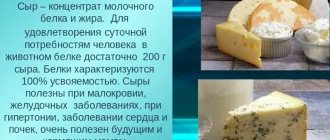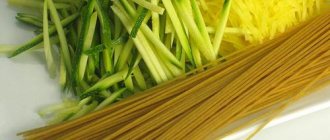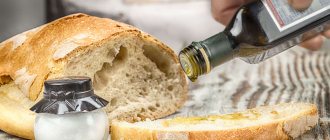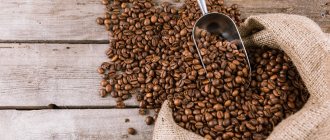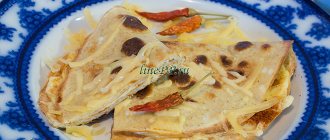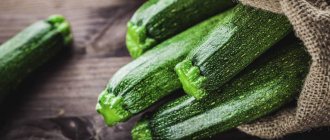What determines the energy value of a flour product?
Today, white bread is not an ordinary brick made from premium wheat flour without any additives. Recently, supermarkets have been offering a huge assortment, including loaves, round and elongated samples, baguette, products with raisins, seeds, sesame and other additives.
White pastries are also made from oat, corn and rye flour. It is important that it is very fine and does not contain bran. The calorie content of white bread depends on the following factors:
- Type of flour. Wheat raw materials do not have the highest indicators (326-329 kilocalories/100 g). The leader in this disappointing ranking is rice flour with a value of 358 kcal. Rye flour is not too far removed from wheat flour - 325 kcal per hundred grams.
- Test recipes. It is clear that the baked goods will “weigh” more than unleavened and yeast-free dough.
- Yeast volume. Different manufacturers add different amounts of yeast to the same dough. The more there are, the higher the value.
- Additives Nuts, dried fruits, raisins, seeds, sesame seeds and other ingredients significantly increase the calorie content of the product.
As you can see, the energy value of a white flour product is a rather variable indicator. If you want to know exactly how many calories are in white bread, look at the label. We will provide you with approximate numbers below. The freshness of baked goods also affects its calorie content. This value for crackers increases as they dehydrate.
Food calorie table
Bread for the diet menu
We will prepare dietary bread with sour milk and without adding yeast. And for taste, add pumpkin seeds and spices to it.
Ingredients:
- eggs - two pieces;
- sour milk - two glasses;
- salt;
- black pepper;
- rye flour - 0.7 kg;
- tarragon seeds - one teaspoon;
- purified vegetable oil – one glass;
- soda – one teaspoon;
- dried greens;
- pumpkin seeds.
On a note! Instead of sour milk, you can use kefir or classic low-fat yogurt as a base for bread.
Preparation:
- Beat eggs into a blender container.
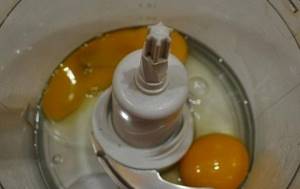
- Add sour milk to them.

- Add black pepper and salt.
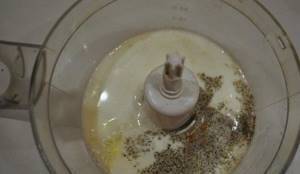
- Now add a third of the rye flour to the blender container.
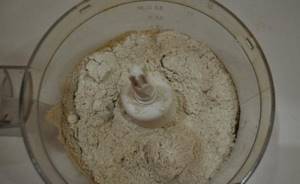
- Let's run the blender for a minute. We need all components to “connect” with each other.
- Add tarragon seeds.
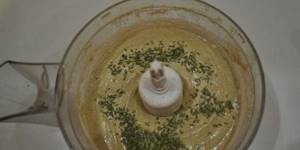
- Without stirring the mixture, add half a glass of purified vegetable oil. By the way, it will be delicious if you use grape oil.
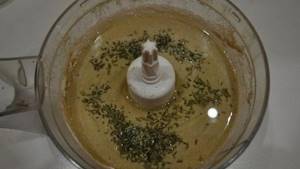
- Let's work with the blender for a couple of minutes so that the mass acquires a uniform structure.
- Let's introduce soda. First extinguish it with lemon juice or vinegar.
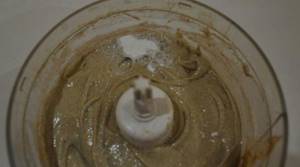
- Add greens. It is better to use dried parsley.
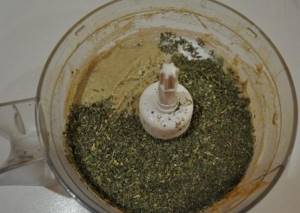
- Stir the mixture with a blender until it becomes a homogeneous structure.
- Add pumpkin seeds.
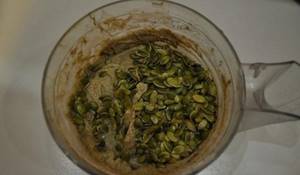
- Now we need to work with our hands. Stir pumpkin seeds into the base.
- Dust the work surface with flour. Let's lay out our base on it.
- Knead the base, slowly adding the remaining flour to it. The finished base should not stick. Do not add more flour than recommended. To achieve the desired structure, gradually add vegetable oil. It will make the bread elastic and soft.
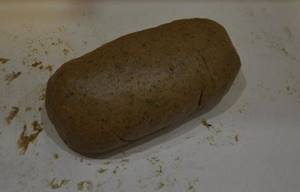
- Let the dough sit for half an hour until it rises slightly.
- Then line the baking sheet with a sheet of baking paper.
- From the dough piece we form small-sized cods. Place them on a baking sheet.
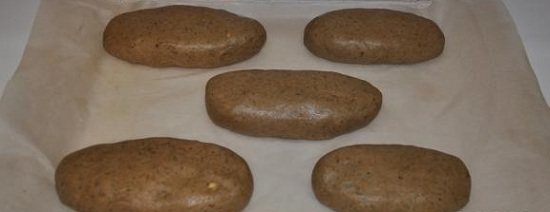
- Using a knife, make cuts on the workpieces. The movements should be pressing.

- Warm up the oven for literally five minutes. We place our preparations in it.
- The oven must be “accelerated” to two hundred and ten degrees. While it warms up, the bread will rise slightly.
- We bake the bread for half an hour - forty minutes.
Calorie content of bread under a microscope
Very often, in pursuit of reducing calorie intake, most of us start by replacing the white crispy baguette on our dinner table with wholemeal bread. Wholemeal bread is considered almost synonymous with slimness. Is this right or wrong?
We must admit that this is all a big hoax. Wholemeal bread contains no less calories than white bread. The difference in calories between the two is simply anecdotal. So, 100 g of white bread contains 265 Kcal, while a loaf made from wholemeal flour contains 250 Kcal. White bread contains slightly more calories due to the addition of low amounts of sugar and fat.
A standard portion of bread is considered to be a piece about 10 mm thick, the size of which is equal to ½ of the cross section in the middle of the loaf or loaf. The weight of such a portion of bread is approximately 20 to 30 g.
Now we know all the initial data, and we know how many calories are in a loaf of white bread. Let's try to find out how many calories are in a piece of white bread. Since it is unlikely that it will be possible to cut off exactly 20 or 30 g, we will focus on the average value, namely 25 g. The number 25 is exactly 4 times less than 100. It is logical to assume that the number of calories contained in a piece weighing 25 g will be less in 4 times than in 100 g. That is, if the calorie content of 100 g of white bread is 265 Kcal, respectively, 25 g will contain: 265 / 4 = 66.3 Kcal.
Having carried out a similar calculation with a piece of rye bread, we find out that its nutritional value will be equal to 62.5 Kcal. As you can see, the difference is not too big. For diet purposes, the problem may not lie in calories per se, but in the amount of food containing them consumed. But this is a question, rather, for nutritionists.
There is another opinion that if you replace fresh white bread on the table with crackers, then your diet will immediately improve. What can you say about this? By and large, crackers are the same bread, only dried, that is, with zero water content. And water, as you know, has no effect on calorie content. So it turns out that white bread crumbs contain the same number of calories as fresh baked goods. Here again we return to the amount of food eaten. In any case, they eat less crackers at lunch than a crispy white loaf.
If you look at how many calories are in white bread crackers, in those same rounds or squares from bright little bags with flashy names, you will be “pleasantly” surprised. The fact is that their calorie content is 25-30% higher than that of bread. Thus, the nutritional value of 100 g of crackers is 331 Kcal. This is easily explained: their production additionally uses fats and oils, which add calories.
Calorie content
Wheat bread contains 213.6 kilocalories. The nutritional value, or the content of proteins, fats and carbohydrates, is 7.6/0.9/46.7 g. One bun (usually weighing 400 g) contains 1060 kcal. On average, 1 piece of bread contains from 50 to 70 calories.
The exact value of how many calories will be added can be found out by weighing 1 slice. Below are the calorie numbers depending on the type (per 100 grams):
| Types of flour products | Number of calories (kcal) | Composition of BJU (g) |
| White | 253,66 | 8,04/2,66/48,01 |
| Black | 208,29 | 7,12/1,57/39,55 |
| Rye | 250 | 13,0/3,0/40 |
| Grey | 254,66 | 8,97/2,71/48,24 |
| Borodinsky | 208 | 6,9/1 ,3/40,9 |
| Yeast-free | 221 | 6,9/1,2/43,4 |
| Bogorodsky | 220,8 | 6,8/1,05/45,74 |
| With bran | 227 | 7,5/1,3/45,2 |
| With buckwheat flour | 288 | 7,1/2,5/45,8 |
| Dietary | 214,9 | 5,6/1,9/45,3 |
Bread crumbs contain 331 kcal, 11.2 g of protein, 1.4 g of fat and 72.2 g of carbohydrates. Borodino contains the least amount of calories.
Calorie content of white bread with butter
Bread is a quick way to saturate your body with essential nutrients and energy for a long time. Most often, people do not have time to prepare full meals, so most people choose a sandwich with butter for a snack.
The calorie content of a 40 gram slice of white bread with butter is about 154 kcal. The nutritional value of 100 grams of a white bun with butter reaches 385 kcal.
People who are watching their figure can reduce the piece of flour they consume, and in order to reduce the calorie content of one meal, they need to reduce the portion of the dish itself. It is best to eat dried bread, as it contains fewer calories than freshly baked bread.
Consuming it in moderation will not harm your health in any way and will not add extra pounds. What is of great importance is not what kind of bread you eat, but what kind of diet and life you follow in general. A delicious fluffy bun will perfectly complement the taste of your favorite dish, making it healthier and more satisfying.
Homemade butter - quick and easy!
Store-bought oil, of course, can be of high quality, but you can hardly find such a product better than homemade one. It's easy to prepare. For this we only need sour cream. Choose a homemade product with a fat content of forty-five to fifty-five percent.
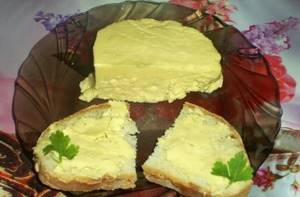
Ingredients:
- sour cream – 500 ml.
Preparation:
- So, in addition to sour cream, we will also need a mixer (or food processor). Let's prepare everything.
- Place sour cream in a deep container.
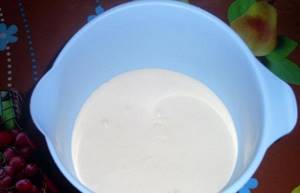
- Set the mixer to high speed. Beat the mass. After a minute it will begin to turn yellow and thicken. That is, we will get a mass of homogeneous oily structure.
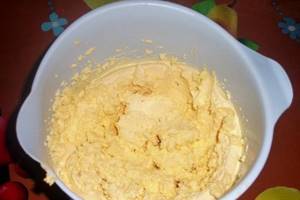
- But the oil is not ready yet. Let's reduce the speed a little. Let's continue working with the mixer. After a minute, you will see that liquid is leaving the total mass. This is buttermilk.
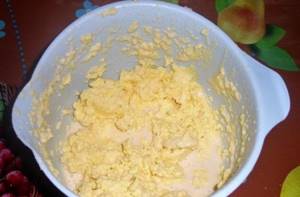
- Using a spoon, carefully place the butter into a plate. But the buttermilk should remain in the container.
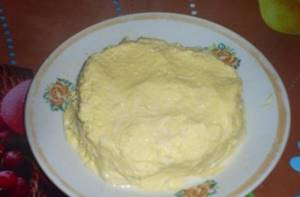
- Let's wait a little while the remaining buttermilk drains from the oil. Let's salt it. Let's give the butter its shape. Let's put it in the freezer for thirty minutes. Ready!
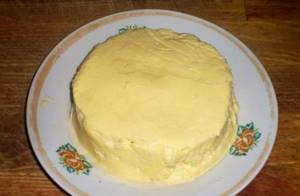
- Now we can make sandwiches. Feel free to complement them with greens - both healthy and low in calories!
On a note! From 500 ml of sour cream you will get three hundred and fifty grams of butter.
White bread with cheese (with butter and cheese)
The rhythm of life of a modern person does not allow preparing complex dishes, especially for lunch. Therefore, the sandwich is a popular cold snack for a quick meal, since it is much easier to throw various ingredients on white bread and eat along the way. The nutritional value of such a sandwich depends on the amount of ingredients.
Bread with butter and cheese is the best option for a snack in the first half of the day, since carbohydrates are digested until the evening and are not stored in excess fat folds. The calorie content of a piece of white bread with cheese and butter is approximately 170 kcal.
After studying the calorie content of a flour product with added ingredients, you can fall into depression, but not everything is so sad. You shouldn’t eat bread in large quantities, but you don’t need to be upset about having a necessary snack several times a week.
These sandwiches can easily be made healthier by adding fresh vegetables and herbs. Parsley, tomato, cucumber and garlic perfectly break down fats, thereby helping to slightly neutralize the nutritional value of hearty bread.
Nutritionists have developed a daily norm for the consumption of bakery products, which will help you correctly create a menu and not gain extra pounds: women should not eat more than 350 kcal, and men should not eat more than 450. When compiling a daily diet, you need to take into account not only the calorie content of flour products, but also other food products .
Recipe Sandwich with butter and jam. Calorie, chemical composition and nutritional value.
Nutritional value and chemical composition of “Sandwich with butter and jam.”
The table shows the nutritional content (calories, proteins, fats, carbohydrates, vitamins and minerals) per 100 grams of edible portion.
| Nutrient | Quantity | Norm** | % of the norm in 100 g | % of the norm in 100 kcal | 100% normal |
| Calorie content | 268.6 kcal | 1684 kcal | 16% | 6% | 627 g |
| Squirrels | 4.3 g | 76 g | 5.7% | 2.1% | 1767 |
| Fats | 8.1 g | 56 g | 14.5% | 5.4% | 691 g |
| Carbohydrates | 45.1 g | 219 g | 20.6% | 7.7% | 486 g |
| Organic acids | 0.7 g | ~ | |||
| Alimentary fiber | 5.3 g | 20 g | 26.5% | 9.9% | 377 g |
| Water | 35.3 g | 2273 g | 1.6% | 0.6% | 6439 g |
| Ash | 1.15 g | ~ | |||
| Vitamins | |||||
| Vitamin A, RE | 46.5 mcg | 900 mcg | 5.2% | 1.9% | 1935 |
| Retinol | 0.04 mg | ~ | |||
| beta carotene | 0.039 mg | 5 mg | 0.8% | 0.3% | 12821 g |
| Vitamin B1, thiamine | 0.112 mg | 1.5 mg | 7.5% | 2.8% | 1339 g |
| Vitamin B2, riboflavin | 0.072 mg | 1.8 mg | 4% | 1.5% | 2500 g |
| Vitamin B4, choline | 36 mg | 500 mg | 7.2% | 2.7% | 1389 g |
| Vitamin B5, pantothenic | 0.27 mg | 5 mg | 5.4% | 2% | 1852 |
| Vitamin B6, pyridoxine | 0.096 mg | 2 mg | 4.8% | 1.8% | 2083 g |
| Vitamin B9, folates | 18 mcg | 400 mcg | 4.5% | 1.7% | 2222 g |
| Vitamin C, ascorbic acid | 2.22 mg | 90 mg | 2.5% | 0.9% | 4054 g |
| Vitamin D, calciferol | 0.13 mcg | 10 mcg | 1.3% | 0.5% | 7692 g |
| Vitamin E, alpha tocopherol, TE | 1.09 mg | 15 mg | 7.3% | 2.7% | 1376 g |
| Vitamin H, biotin | 1.02 mcg | 50 mcg | 2% | 0.7% | 4902 g |
| Vitamin RR, NE | 1.55 mg | 20 mg | 7.8% | 2.9% | 1290 g |
| Niacin | 0.73 mg | ~ | |||
| Macronutrients | |||||
| Potassium, K | 194.4 mg | 2500 mg | 7.8% | 2.9% | 1286 g |
| Calcium, Ca | 36.3 mg | 1000 mg | 3.6% | 1.3% | 2755 g |
| Silicon, Si | 3.3 mg | 30 mg | 11% | 4.1% | 909 g |
| Magnesium, Mg | 32.45 mg | 400 mg | 8.1% | 3% | 1233 g |
| Sodium, Na | 153.3 mg | 1300 mg | 11.8% | 4.4% | 848 g |
| Sera, S | 36.8 mg | 1000 mg | 3.7% | 1.4% | 2717 g |
| Phosphorus, P | 102 mg | 800 mg | 12.8% | 4.8% | 784 g |
| Chlorine, Cl | 540 mg | 2300 mg | 23.5% | 8.7% | 426 g |
| Microelements | |||||
| Bor, B | 25.2 mcg | ~ | |||
| Vanadium, V | 25.8 mcg | ~ | |||
| Iron, Fe | 2.72 mg | 18 mg | 15.1% | 5.6% | 662 g |
| Yod, I | 2.64 mcg | 150 mcg | 1.8% | 0.7% | 5682 g |
| Cobalt, Co | 1.2 mcg | 10 mcg | 12% | 4.5% | 833 g |
| Manganese, Mn | 0.7204 mg | 2 mg | 36% | 13.4% | 278 g |
| Copper, Cu | 110.4 mcg | 1000 mcg | 11% | 4.1% | 906 g |
| Selenium, Se | 3.3 mcg | 55 mcg | 6% | 2.2% | 1667 g |
| Fluorine, F | 14.4 mcg | 4000 mcg | 0.4% | 0.1% | 27778 g |
| Chromium, Cr | 1.8 mcg | 50 mcg | 3.6% | 1.3% | 2778 g |
| Zinc, Zn | 0.735 mg | 12 mg | 6.1% | 2.3% | 1633 g |
| Digestible carbohydrates | |||||
| Starch and dextrins | 20.91 g | ~ | |||
| Mono- and disaccharides (sugars) | 24.2 g | max 100 g | |||
| Essential amino acids | 0.0353 g | ~ | |||
| Arginine* | 0.0026 g | ~ | |||
| Valin | 0.0042 g | ~ | |||
| Histidine* | 0.0035 g | ~ | |||
| Isoleucine | 0.0041 g | ~ | |||
| Leucine | 0.0076 g | ~ | |||
| Lysine | 0.0045 g | ~ | |||
| Methionine | 0.0017 g | ~ | |||
| Methionine + Cysteine | 0.003 g | ~ | |||
| Threonine | 0.0047 g | ~ | |||
| Tryptophan | 0.0043 g | ~ | |||
| Phenylalanine | 0.0042 g | ~ | |||
| Phenylalanine+Tyrosine | 0.008 g | ~ | |||
| Nonessential amino acids | 0.0474 g | ~ | |||
| Alanin | 0.0036 g | ~ | |||
| Aspartic acid | 0.0057 g | ~ | |||
| Glycine | 0.0024 g | ~ | |||
| Glutamic acid | 0.0142 g | ~ | |||
| Proline | 0.0048 g | ~ | |||
| Serin | 0.0054 g | ~ | |||
| Tyrosine | 0.0042 g | ~ | |||
| Cysteine | 0.001 g | ~ | |||
| Sterols (sterols) | |||||
| Cholesterol | 17 mg | max 300 mg | |||
| Saturated fatty acids | |||||
| Saturated fatty acids | 4.8 g | max 18.7 g | |||
| 4:0 Oil | 0.269 g | ~ | |||
| 6:0 Kapronovaya | 0.123 g | ~ | |||
| 8:0 Caprylic | 0.066 g | ~ | |||
| 10:0 Kaprinovaya | 0.151 g | ~ | |||
| 12:0 Lauric | 0.172 g | ~ | |||
| 14:0 Miristinovaya | 0.794 g | ~ | |||
| 16:0 Palmitinaya | 2.208 g | ~ | |||
| 18:0 Stearic | 0.682 g | ~ | |||
| Monounsaturated fatty acids | 2.206 g | min 16.8 g | 13.1% | 4.9% | |
| 14:1 Myristoleic | 0.154 g | ~ | |||
| 16:1 Palmitoleic | 0.232 g | ~ | |||
| 18:1 Oleic (omega-9) | 1.801 g | ~ | |||
| Polyunsaturated fatty acids | 0.098 g | from 11.2 to 20.6 g | 0.9% | 0.3% | |
| 18:2 Linolevaya | 0.091 g | ~ | |||
| 18:3 Linolenic | 0.007 g | ~ | |||
| Omega-6 fatty acids | 0.1 g | from 4.7 to 16.8 g | 2.1% | 0.8% |
The energy value of a sandwich with butter and jam is 268.6 kcal.
Primary Source: Created in the application by the user. Read more.
** This table shows the average levels of vitamins and minerals for an adult. If you want to know the norms taking into account your gender, age and other factors, then use the “My Healthy Diet” application.
White bread, benefits and dietary properties:
Usually, this bread is usually criticized for its high calorie content and lower concentration of nutrients compared to black or bran bread. Many nutritionists advise excluding this product from your menu, especially when you are prescribed some kind of diet. But if you have a diet that limits only the number of calories, then bread, including white bread, can be consumed, of course, within reasonable limits.
What are the benefits of white bread? First of all, this product is rich in vitamins. Especially B vitamins and vitamin PP, which are necessary for the normal functioning of the immune and nervous systems. For example, a lack of vitamin B1 can cause you irritation and depression. And vitamin B2 is a kind of vitamin of youth, as it helps your skin to be young, elastic and smooth. And vitamin PP helps normalize the functioning of the cardiovascular system.
This type of bread is not deprived of macro and microelements that are very important for human health. Of the most important, it is worth noting iron, phosphorus and calcium. Iron is extremely necessary for people suffering from anemia, as it maintains a normal level of hemoglobin in the blood, phosphorus and calcium are extremely necessary for the full and proper formation of human bones and teeth.
It is worth paying attention to the protein composition of white bread. The proteins that make up this product consist of many essential amino acids. The most important are lysine and methionine. It is thanks to this that white bread is so easily and simply absorbed by the human body. So if you want to be young and healthy, eat white bread, but don't forget about other types of bread.
All about green buckwheat
Is it possible to include white bread in your diet?
There is no need to give up bread completely when dieting. As we said, it's all about quantity. Excessive consumption of bread with all kinds of products, including light snacks like small sandwiches, leads to extra pounds.
It is possible and necessary to eat bread while on a diet, but its consumption should be reduced. Nutritionists say that for those who are struggling with extra pounds, it is enough to eat 50 g of white bread per day. Previously, we determined how many calories are in 1 slice of white bread. Since 50 g is the total weight of two pieces, then in terms of calories it is almost 133 Kcal.
Diet according to blood type. To each his own
How to calculate the calorie content of baked goods?
One piece of both black and white products weighs on average 30-40 g. To avoid miscalculation, divide the calorie content indicated per 100 g by two. If you can't give up baking, then replace it with a low-calorie option. Usually it has a larger volume, which allows you to be sated on a psychological level.
Consider the total daily energy value of white, brown bread and crackers. Men with normal weight should consume about 450 kilocalories per day from flour products, women - 350 kcal.
But if you're looking to lose weight, one piece of white pastry should be your limit. Focus on eating black and whole grain products (its calorie content is 246 kcal/one hundred grams), or crackers made from them.

